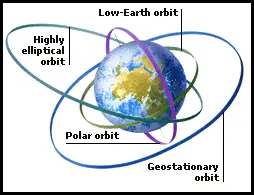A Geosynchronous Equatorial Orbit (GEO) is located exactly 22,336 miles out in space directly above the Earth’s equator. A satellite in a GEO orbit takes a full 24 hours to circle the Earth. That means a satellite in GEO is always directly over the same spot on Earth. GEO can also be called a Geostationary Orbit.
A GEO can only be achieved at an altitude very close to 35,786 km (22,236 mi). This equates to an orbital velocity of 3.07 km/s (1.91 mi/s) or a period of 1,436 minutes, which equates to almost exactly one sidereal day or 23.934461223 hours. This ensures that the satellite is locked to the Earth’s rotational period and has a stationary footprint on the ground. All geostationary satellites have to be located on this ring. [1]
Orbit located at 22,236 miles above the equator
Most commercial and military communications satellites and broadcast satellites operate at GEO. A geostationary transfer orbit is used to move a satellite from low Earth orbit (LEO) into a GEO.
Orbit allocation [1]
Satellites in geostationary orbit must all occupy a single ring above the Equator. The requirement to space these satellites apart to avoid harmful radio-frequency interference during operations means that there are a limited number of orbital “slots” available, thus only a limited number of satellites can be operated in geostationary orbit. This has led to conflict between different countries wishing access to the same orbital slots (countries near the same longitude but differing latitudes) and radio frequencies. These disputes are addressed through the International Telecommunication Union’s allocation mechanism. In the 1976 Bogotá Declaration, eight countries located on the Earth’s equator claimed sovereignty over the geostationary orbits above their territory, but the claims gained no international recognition.
Limitations to usable life of geostationary satellites [1]
When they run out of thruster fuel, the satellites are at the end of their service life as they are no longer able to keep in their allocated orbital position. The transponders and other onboard systems generally outlive the thruster fuel and, by stopping N-S station keeping, some satellites can continue to be used in inclined orbits (where the orbital track appears to follow a figure-eight loop centred on the Equator), or else be elevated to a “graveyard” disposal orbit.
AcqLinks and References:
- [1] Website: Wikipedia – Geosynchronous Equatorial Orbit (GEO)
- Website: Rocket and Space Technology

